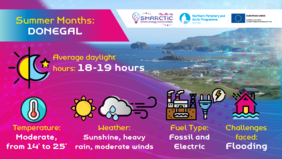SMARCTIC partner Donegal County Council is the Local Authority for County Donegal, located in the north-west of Ireland in the province of Ulster. It borders the counties of Leitrim, Derry, Tyrone and Fermanagh. The coastline of Co. Donegal is the longest in Ireland at 1,235 km. The Inishowen Peninsula and the Fanad Peninsula offer dramatic cliffs, long sandy beaches and dunes. Donegal is also the location of the highest sea cliffs in Ireland, at Slieve League.
County Donegal’s population has greatly increased in the last decade and is now home to 160,000 people, with 20,000 of the inhabitants centred in Letterkenny, the county’s largest town. The county was once renowned for its textile industry which has ceased to exist in the last number of decades. Agriculture remains a strong contributor to culture and the economy in the region.
Donegal is known as a ‘border county’ based on its shared border with three counties of Northern Ireland, one of which is County Derry whose local authority (Derry City & Strabane District Council) is also a partner on the SMARCTIC project. Much of the population maintain a cross-border lifestyle, crossing the border regularly for reasons of family and employment.
The region is located on the Northern Periphery of Europe and experiences moderate temperatures for much of the year. During the summer months the temperature averages at 14 degrees with occasional warmer bursts of up to 25 degrees. July is typically the warmest month but there are no guarantees… Donegal residents make the most of any sunshine available to them and try to spend as much time outdoors as possible when the weather is good. Despite the warmer temperatures, the region still experiences a large amount of rainfall in the summer months and can be prone to flooding during the season. Heavy rain often forces people to stay indoors, even when the days are relatively warm.
Daylight hours are long in the region during summer. Around Summer Solstice there is 18-19 hours of light each day with sunrise at around 4am and sunset at around 11pm. During these months it can be possible to see the Aurora Borealis from Malin Head, the most northern point on the island of Ireland!
Despite the rise in temperature during summer, energy expenditure in the region does not deviate greatly. Large amounts of energy are still expended for municipal and public buildings and domestic use as households may still require heat and often require energy to produce hot water that would usually be generated by boiler systems in the wintertime. “In the wintertime homes in the region depend largely on oil and solid fuels such as coal to heat their homes and water… in the summer months there is a definite switch to electricity for the purpose of heating water via the immersion system”, states Juanita Blue, SMARCTIC Project Manager.
Renewable sources vs. fossil fuels
Unfortunately, due to the lower levels of sunshine experienced in the region, domestic use of renewable sources of energy such as solar PV cannot be depended up solely for energy generation, fossil fuels are still required. The SMARCTIC project aims to address these types of issues in Northern Periphery & Arctic Regions. SMARCTIC aims to encourage and facilitate SMART energy communities by using SMART technology and visualisation tools to educate and reduce energy use in the regions throughout the year; and to demonstrate effective implementation of intelligent solutions and renewable resources to reduce overall consumption.

